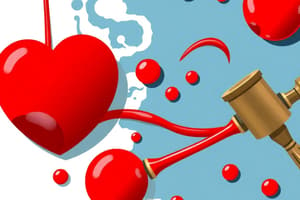Podcast
Questions and Answers
Why is blood currently considered irreplaceable by science?
Why is blood currently considered irreplaceable by science?
- Due to legal restrictions on experimenting with blood substitutes.
- Because the technology to create artificial blood is too expensive.
- Due to its complex composition and multiple critical functions that no single substitute can replicate. (correct)
- Because it is too difficult to synthesize in a lab environment.
Blood accounts for approximately 25% of a person's body weight.
Blood accounts for approximately 25% of a person's body weight.
False (B)
List three key functions of blood.
List three key functions of blood.
- Transports oxygen, nutrients, waste, and hormones. 2. Regulates body temperature and pH levels. 3. Protects against infection and blood loss.
After donating blood, it is tested for __________ and separated into components.
After donating blood, it is tested for __________ and separated into components.
Match the blood component with its primary function:
Match the blood component with its primary function:
Flashcards
Why is blood irreplaceable?
Why is blood irreplaceable?
Essential bodily fluid that science cannot currently replace.
Key functions of blood
Key functions of blood
Transports oxygen/nutrients, regulates temperature/pH, maintains fluid volume, protects against infection/blood loss.
Characteristics of Blood
Characteristics of Blood
Accounts for about 8% of body weight and has a salty, metallic taste.
Formed elements of blood
Formed elements of blood
Signup and view all the flashcards
Blood Separation
Blood Separation
Signup and view all the flashcards
Study Notes
The Irreplaceability of Blood
- Science is able to replace many body parts, but not blood.
- Blood is essential and often required for injuries or illnesses.
- Every two seconds, someone in the U.S. requires a blood transfusion.
- The 16 million pints of blood required each year in the U.S. must come from donors.
Blood Composition and Function
- Blood has a red, sticky, salty, and metallic taste.
- Blood accounts for about 8% of body weight.
- Blood is a connective tissue comprised of living cells in a nonliving matrix, or plasma.
- Key functions of blood:
- Transports oxygen, nutrients, waste, and hormones.
- Regulates body temperature and pH levels.
- Maintains fluid volume.
- Protects against infection and blood loss.
The Blood Donation Process
- At blood drives, about a pint of blood is taken in 20 minutes after a finger prick.
- After donation, blood is tested for diseases and separated into components.
Blood Components
- Whole blood contains formed elements which are cells and fragments, water, and dissolved molecules.
- A centrifuge separates blood into:
- Erythrocytes (red blood cells): 45% of blood volume, and they carry oxygen and carbon dioxide
- Leukocytes (white blood cells) and Platelets: <1% of blood, leukocytes defend against toxins, platelets aid clotting
- Plasma: 55% of blood volume, 90% water, 10% solutes (proteins, electrolytes, gases, hormones, waste)
- Electrolytes, such as calcium, sodium, potassium, phosphate, sulfate, and bicarbonate, regulate blood chemistry and osmotic pressure.
- Plasma proteins, such as albumin and globulins, maintain osmotic pressure, transport lipids, and aid in defense and clotting.
Hemostasis
- Hemostasis prevents excessive blood loss.
- The initial response is blood vessel constriction to slow blood flow.
- Platelet Plug Formation- Platelets gather at the injury site, becoming sticky when reacting with exposed collagen fibers.
- Fibrin Clot Reinforcement- Fibrin threads form a mesh to trap platelets and blood cells, closing the vessel wall.
- Clot Dissolution: The blood vessel heals and the blood clot dissolves over time.
Hemophilia
- Hemophilia is a disorder where fibrin clot formation is ineffective.
- Hemophiliacs bleed for a longer time after injury, and often require transfusions.
Blood Types
- Blood types are categorized as A, B, AB, or O, and this is based on antigens and immune system compatibility.
- Antigens are glycoprotein markers on cells that identify them.
- During an immune response, antibodies detect foreign cells and bind to antigens to tag cells for destruction.
- Agglutinogens are specialized antigens on red blood cells that activate antibodies that cause coagulation.
- Type A has A antigens.
- Type B has B antigens.
- Type AB has both A and B antigens.
- Type O has neither A nor B antigens.
Blood Type Compatibility
- AB-type blood is known as universal recipients because it is able to accept any blood type because it has both antigens and no antibodies.
- O-type blood is known as universal donors as it can mix with other blood types without causing a reaction because it lacks antigens.
- O-types can only receive O-type blood.
Rh Factor
- Rh antigens determine whether blood is Rh positive or Rh negative.
- Most of the population is Rh positive, but negative types should stick to Rh negative blood.
- The combination of A-B antigens and Rh factors results in eight different blood types.
Studying That Suits You
Use AI to generate personalized quizzes and flashcards to suit your learning preferences.




